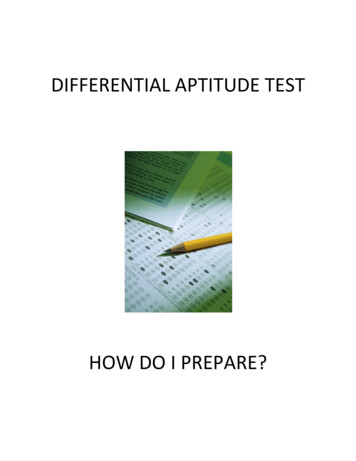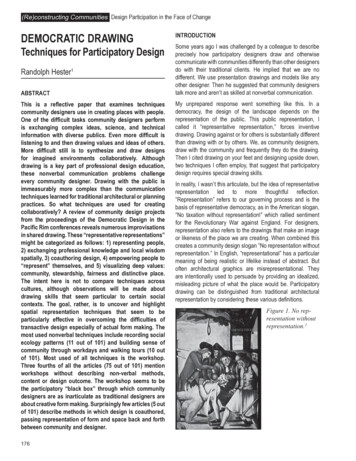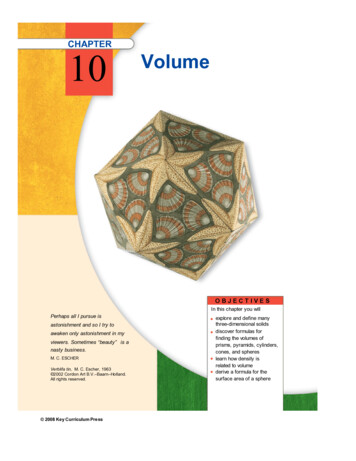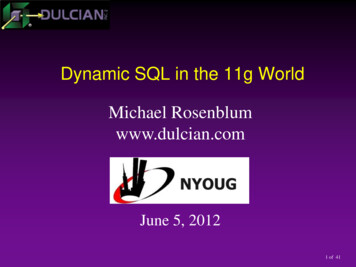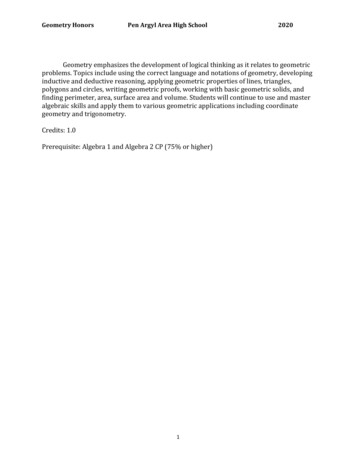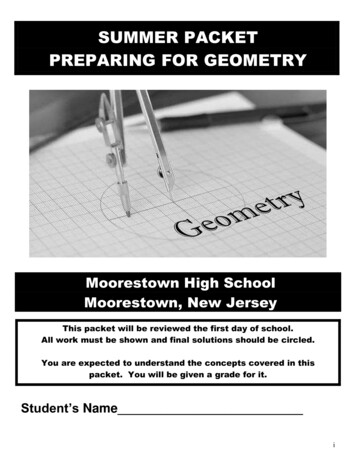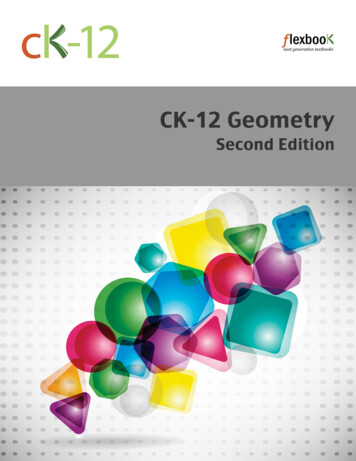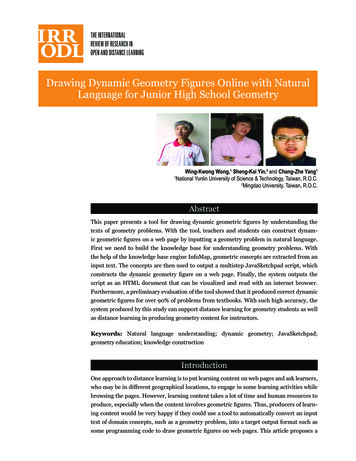
Transcription
Drawing Dynamic Geometry Figures Online with NaturalLanguage for Junior High School Geometry1Wing-Kwong Wong,1 Sheng-Kai Yin,2 and Chang-Zhe Yang1National Yunlin University of Science & Technology, Taiwan, R.O.C.2Mingdao University, Taiwan, R.O.C.AbstractThis paper presents a tool for drawing dynamic geometric figures by understanding thetexts of geometry problems. With the tool, teachers and students can construct dynamic geometric figures on a web page by inputting a geometry problem in natural language.First we need to build the knowledge base for understanding geometry problems. Withthe help of the knowledge base engine InfoMap, geometric concepts are extracted from aninput text. The concepts are then used to output a multistep JavaSketchpad script, whichconstructs the dynamic geometry figure on a web page. Finally, the system outputs thescript as an HTML document that can be visualized and read with an internet browser.Furthermore, a preliminary evaluation of the tool showed that it produced correct dynamicgeometric figures for over 90% of problems from textbooks. With such high accuracy, thesystem produced by this study can support distance learning for geometry students as wellas distance learning in producing geometry content for instructors.Keywords: Natural language understanding; dynamic geometry; JavaSketchpad;geometry education; knowledge constructionIntroductionOne approach to distance learning is to put learning content on web pages and ask learners,who may be in different geographical locations, to engage in some learning activities whilebrowsing the pages. However, learning content takes a lot of time and human resources toproduce, especially when the content involves geometric figures. Thus, producers of learning content would be very happy if they could use a tool to automatically convert an inputtext of domain concepts, such as a geometry problem, into a target output format such assome programming code to draw geometric figures on web pages. This article proposes a
Drawing Dynamic Geometry Figures Online with Natural Language for Junior High School GeometryWong, Yin, and Yangmethodology of how to convert input texts of domain concepts into some target output format. The methodology is illustrated by the construction of an actual system in convertinginput texts of geometry problems at a junior high school level into JavaSketchpad scripts todisplay dynamic geometry (DG) figures on a web page.The National Council of Teachers of Mathematics (NCTM) has published two importantdocuments on K-12 mathematics curriculum: Curriculum and Evaluation Standards forSchool Mathematics (1989) and Principles and Standards for School Mathematics (2000).The latter focused more on the skill of writing formal proofs of geometry (Knuth, 2002).Furthermore, mathematicians and educators agree that writing geometry proofs involvesimportant skills that are difficult to learn (Koedinger, 1998; Whiteley, 1999).Using geometry software increases the motivation of students in learning geometry. Somepopular programs include Geometer’s Sketchpad (GSP, http://www.keypress.com/sketchpad/), Cabri Geometry II (http://www.cabri.com/v2/pages/en/index.php), Geometry Expert (Chou et al., 1996), and Cinderella’s Café (http://www.cinderella.de/tiki-index.php).These programs share one common focus on dynamic geometry figures. In a dynamic geometry figure, students can drag a geometry object such as a vertex of a triangle and changethe figure dynamically while preserving the geometric invariants, which are the consequences of the given conditions. Thus these programs are commonly used to demonstrategeometry theorems.Dynamic geometry can also be used by students to discover conjectures about a figure insome given conditions. Students can explore the variations of a dynamic geometry figureand try to discover conjectures about the figure on their own (Jones, 2000). In a study,students are given work sheets to fill in measurements of some properties of geometricobjects, and they write down conjectures they discover in a dynamic figure (Furinghetti &Paola, 2003). There are two common problems in such learning activities. First, teachersand students have to learn to use the DG software and the learning process can be difficult.Second, there is no detailed record on how students manipulate the dynamic figures in order to support the findings of the study on these activities. Both problems make it difficultto evaluate the learning effectiveness of the students in using a dynamic geometry system.To address the above two problems, we built an online dynamic geometry system that can“understand” geometry problems. With this system, the teachers and students can construct dynamic geometric figures on a web page for their learning activities, such as makinggeometry conjectures and proving a theorem. Furthermore, this tool can help researchersto design user interfaces that are capable of recording the data of students’ interactionswith the dynamic geometric figures. Based on the data, researchers can get more insights onhow students make inferences from their interactions with the dynamic figures.In addition to benefitting students, the online dynamic geometry system can be a valuabletool for instructors who struggle to produce the learning content of dynamic geometry. Specifically, two types of instructors can use the system in ways that suit their needs. The firsttype is instructors who do not want to work with JavaSketchpad (JSP). They can directlyVol 13 No 5Research ArticlesDecember 2012127
Drawing Dynamic Geometry Figures Online with Natural Language for Junior High School GeometryWong, Yin, and Yanguse the web pages of learning content generated by the system or enhance those pages withother tools such as Adobe’s Dreamweaver. The second type is instructors who want to learnJSP. They can input a problem text of their choice to the system and get a web page of JSPwith the geometry content. Then they can study how the JSP code produces the dynamicgeometry content they pick. This can be a good way to learn JSP by example. How effectivethis tool is for instructors and learners of geometry really depends on the accuracy of thesystem in producing correct geometry figures. Thus, an objective of this study is to evaluatethe accuracy of the system empirically.This system uses InfoMap (Hsu et al., 2001), which is a knowledge engineering tool forunderstanding natural language. InfoMap analyzes a geometry text by extracting geometric concepts and converting them into JavaSketchpad commands for drawing a dynamicfigure. Then the system embeds the script in a web page, which can show the dynamic geometry figure on an internet browser. The article is organized as follows. The literature onattempts to solve the problem of learning JSP is first reviewed. Based on our previous study(Wong et al., 2007), a methodology and the core technologies of the system are presented.We also empirically tested the system with geometry problems from three main referencebooks for junior high schools in Taiwan. At the end of the article, some empirical resultsand conclusive remarks are reported, and future work is suggested.Roles of DGE and Instructional Design in Geometry LearningIn research literature, there is yet no satisfactory explanation of how experimentation withdynamic geometry can help the acquisition of skills for formal theorem proving. Researchers think there is a big gap between the experience of dynamic geometry and the learningof formal proof production. Some studies also found that object dragging in a dynamicgeometry environment (DGE) can reduce the gap between dynamic geometry experimentation and the generation of theorem proving ideas by learners. As a result, many researchersdesign some activities in a DGE and study what types of learning result from such activitiesand the nature of the learning process (e.g., Leung & Lopez-Real, 2003; Hoyles & Healy,1999; Furinghetti & Paoloa, 2003; Christou et. al., 2004).Some studies indicate that when students explored conjectures in a DGE, they could explain the formal proof they wrote based on their experiences in the exploration (e.g., Holys& Healy, 1999). Furthermore, students would strengthen their beliefs in the geometry conjectures they made from their observation of the changes of dynamic figures in a DGE (deVilliers, 1996, 2003). In a DGE, students can drag geometric components and take measurements of geometric objects in a dynamic figure. Then they can notice the variance andinvariance of conditions in a dynamic figure, deepening their understanding of geometrytheorems (Laborde et al., 2006).The ultimate goal of geometry learning is to design a DGE that helps students learn the skillsof theorem proving in geometry. But current DGEs are not designed for this purpose sincethey do not provide any tools with instructional strategies for theorem proving. AlthoughVol 13 No 5Research ArticlesDecember 2012128
Drawing Dynamic Geometry Figures Online with Natural Language for Junior High School GeometryWong, Yin, and Yanga DGE is used in math classes in some schools, many math teachers and researchers thinkthat it is difficult to design instructional materials for a DGE, and students might spendtoo much time in exploring without achieving the final learning objective. Therefore in thedesign of a DGE with specific teaching objectives, educators have to pay special attention tothe design of interfaces for instructor to author guiding instructions and for learners to proceed to the final learning objective through guided exploration. Thus, we need to develop asystem which can support the user interface design of a DGE for specific learning purposes.Problems Using a DGE in ClassWhen a DGE is used in some learning activities, students need both basic geometry knowledge and the knowledge to work in a DGE. Sometimes, they need to add some geometriccomponents in a dynamic figure. This can be an obstacle to some students, reducing theeffectiveness of learning in a DGE (Talmon & Yerushalmy, 2004). Despite the potentialbenefits of using a DGE in geometry classes, a DGE is not available to some schools inTaiwan. We found that in four junior high and high schools, located in urban areas ofYunlin County, teachers have never used a DGE in their classes. We believe many otherschools have similar experiences. Three reasons are suggested for not using a DGE inschool. First, using a DGE might not contribute directly to the performance of students inpublic examinations for entering the next level of schooling. Second, funds are difficult toget for computer equipment. Third, too much time is required for teachers and studentsin learning how to construct dynamic figures in a DGE.In order to address the third problem, some tools are developed to train users to learn towrite JavaSketchpad (JSP, http://www.keypress.com/sketchpad/java gsp/) script. Onthe web page http://www.mathematik.uni-bielefeld.de/ lisken/jsp/, Lisken provides atool, jsp.awk, on which an author can write JavaSketchpad code. When coding is done,the tool embeds the code in an HTML file, which the author can view to check the dynamicfigure with a browser. On the web page ator.htm, Klein provides a similar tool called JSPGenerator, which is an authoringtool written in Javascript to generate JavaSketchpad files. After an author finishes writingJavascript code on JSPGenerator, he can choose to view the dynamic figure generated bythe code in the same window just below the code. This previewing step is an improvementover jsp.awk. In Taiwan, Lin (2006) offers a similar tool called JavaGSP Editor, withwhich learners can write JavaSketchpad scripts and use these scripts in an online learning environment (Figure 1). The tool provides fancy graphical interface components suchas buttons and menus for designing more interactive web pages. The above three toolssimplify the task of producing dynamic figures on web pages. However, these tools stillrequire users to learn JavaSketchpad’s programming syntax and semantics, which canput off many instructors and students in high school.Vol 13 No 5Research ArticlesDecember 2012129
Drawing Dynamic Geometry Figures Online with Natural Language for Junior High School GeometryWong, Yin, and YangFigure 1. JavaSketchpad Editor (the left is Editor, viewer in the right (Lin, 2006)).To make a DGE more accessible to teachers and students, we propose a system that candraw dynamic geometry figures by understanding texts of geometry problems. In this way,teachers and students are not required to spend so much time in constructing figures in aDGE. Moreover, if the system is available on a Web site, then there is no need to install anyexpensive commercial software in school, making a DGE more accessible to schools in poorschool districts.Natural Language Understanding for Computer-Assisted LearningNatural language understanding is a challenging problem in the research of artificial intelligence. Some missions of research on natural language understanding are to analyze andcomprehend human language and answer questions about given texts. With the progressof the research of natural language understanding, these technologies have been appliedto various fields, including semantic web, Chinese speech processing, machine translation,concept modeling, knowledge engineering, and computer-assisted learning. In a study, users can use natural language instead of formal commands to work in the UNIX system(Lees & Cowie, 1996). In a study by Li & Chen (1988), an expert system was constructed forhelping users learn concepts of computer science. In studies by Wong et al. (2007, 2008),a knowledge model of geometric concepts was used to understand word problems of geometry proofs.Lees and Cowie (1996) proposed an enquiry system for training students to learn UNIXcommands. The system provides a natural language interface for learners so that they canlearn UNIX commands by themselves. After a learner inputs a sentence or a UNIX command, the system will parse the sentence with a chart parsing algorithm and generate aUNIX command as a response. The system checks with the learner in a dialog and executesthe command if that is what the learner really wants to do with the input sentence. Li andChen (1988) proposed a Chinese enquiry system about fundamental knowledge of computers. The system uses a linguist string parser to understand the question inputted by alearner, and then outputs an appropriate answer.Vol 13 No 5Research ArticlesDecember 2012130
Drawing Dynamic Geometry Figures Online with Natural Language for Junior High School GeometryWong, Yin, and YangIn Lu et al. (2005), a model is proposed to simulate the procedural knowledge of basic arithmetic operations. The model helps teachers design an appropriate curriculum and teachingstrategy from the records of procedure that students used to solve arithmetic problems.The model is used in an intelligent tutoring system that can accumulate and reproduce theknowledge from teachers and students and help teachers build a good learning map forstudents. Furthermore, a student model, which is built from a collection of students’ errors,can contribute to the design of more suitable teaching tactics.In Wong et al. (2007), a LIM-G (learners’ initiated model for geometry) system is used tounderstand geometry word problems and help elementary school students comprehend geometry word problems, which are about the area or circumference of various shapes. Aftera student inputs a geometry problem to LIM-G, the system understands the geometry problem using prebuilt geometry knowledge and constructs a figure for the problem. Geometryword problems from five textbooks published by five major publishers in Taiwan were usedto evaluate the performance of LIM-G and about 85% of the problems were comprehendedcorrectly.In LIM-G, a cognitive knowledge base is constructed with an ontology-based knowledgeengineering tool called InfoMap (Hsu et al., 2001), whose knowledge base includes generictemplate nodes for problem classes, problem-concept, lexical knowledge, lexicon, and soon. Using a template matching mechanism, InfoMap can extract the attributes and valuesof concepts in a given problem. After reviewing LIM-G and other similar studies, Mukherjee and Garain (2008a) point out that the methodology of natural language understandingtechnology and its application to understanding geometric problems in mathematics is mature for developing real applications. In our study, InfoMap is used to understand an inputproblem of geometry proof by extracting the geometric objects, resulting in a JSP script thatdraws the figure of the problem as a dynamic figure. The next section provides a methodology that other researchers can follow to develop similar systems for their learning areas.MethodologyApplying the model of LIM-G (Wong et al., 2007), Mukherjee and Garain (2008b) implemented a tool for the automatic conversion of any input text about science and engineeringinto a concept map. In Mukherjee and Garain (2011), a knowledge base called GeometryNetwas used in interpreting the geometric meaning of an input text to draw the corresponding diagram. These studies indicate the feasibility of a general approach in converting anyinput text about some subject domain, which is intended for some educational context, intoa target output format such as JSP and concept map.By generalizing and extending the model of LIM-G, we suggest a five-step methodologythat researchers can adopt in automatic construction of figures of learning content in anysubject domain (Figure 2). The first step is to construct a knowledge base (for example, toadd geometric concepts and templates of geometric problems into InfoMap). The secondis to adopt the basic mechanism of text understanding as shown in this article. Sometimes,Vol 13 No 5Research ArticlesDecember 2012131
Drawing Dynamic Geometry Figures Online with Natural Language for Junior High School GeometryWong, Yin, and Yangthe researchers have to apply heuristics to improve the accuracy of text understanding.The third step is to analyze the output format (e.g., JavaSketchpad script and HTML). Thefourth is to design learning activities in which learners use the content. The last step is toevaluate the learning effectiveness with empirical experiments. Based on the empirical results, the developer may need to add more concepts and heuristics for the first two steps.Then the cycle can be repeated until the researchers are satisfied. Following this methodology, we develop a system to convert texts of geometry problems into dynamic geometryfigures embedded in web pages. The system architecture is described next.System ArchitectureThis section describes the overall architecture and user-interface of the system for generating dynamic geometry figures from input geometry problems. There are two main components in this system (Figure 3). The first component is the knowledge engine InfoMap.When a user enters a geometry problem in natural language, InfoMap analyzes the problemand extracts the attributes and values of the geometric concepts in the problem. This information is sent to the second component of the system, which is a script generator. Thiscomponent generates a JSP script that draws a dynamic geometric figure of the problemembedded in an HTML document, which can be loaded by any web browser to display thedynamic geometry figure.Vol 13 No 5Research ArticlesDecember 2012132
Drawing Dynamic Geometry Figures Online with Natural Language for Junior High School GeometryWong, Yin, and YangFigure 4 shows a snapshot of the user-interface in a web browser. A user can input thegeometry problem in Chinese and simple mathematical symbols in the text area at the bottom. The canvas at the top displays the dynamic figure based on the system’s analysis ofthe input problem. The figure is drawn with a JavaSketchpad script embedded in an HTMLdocument.Vol 13 No 5Research ArticlesDecember 2012133
Drawing Dynamic Geometry Figures Online with Natural Language for Junior High School GeometryWong, Yin, and YangInfoMapInfoMap is a knowledge engineering tool provided by the Intelligent Agent System Lab,Institute of Information Science, Academia Sinica. InfoMap is an ontology-based systemfor knowledge representation and template matching (Hsu et al., 2001). InfoMap works asan agent by understanding texts in any domain and can answer questions about them if theneeded domain knowledge is provided. In order to use the tool for this study, we must firstbuild the basic knowledge for geometry problems.Figure 5. Inquiring a knowledge base of InfoMap.In a knowledge base in InfoMap, nodes represent geometry concepts and each template ofa node specifies the syntax of a sentence that involves the concept of the node. Templatesare matched to input sentences in order to extract the concepts from the sentences. Figure5 shows a tool for getting information from the knowledge base of InfoMap. Before thesystem can parse an input sentence, the system must load a knowledge base of geometryconcepts in InfoMap. A user first inputs a sentence in the text area at the top. Then InfoMaptriggers the templates that match the input problem, the parent nodes of the templates andthe referenced nodes, extracting these nodes and their contents. Users can see the details ofthe knowledge base and the triggered nodes, which are colored in red (Figure 5).Knowledge Base of Geometric ConceptsBefore InfoMap can perform the understanding task, we need to build a knowledge base ofgeometry concepts first. Figure 6 shows part of the knowledge base, which includes manyconcepts (e.g., midpoint, pedal point, intersection, triangle, isosceles triangle, regular triangle, parallelogram, parallel line, point on line). In this study, we have built more than 50nodes of geometric concepts. We can always add more concepts when needed.Vol 13 No 5Research ArticlesDecember 2012134
Drawing Dynamic Geometry Figures Online with Natural Language for Junior High School GeometryWong, Yin, and YangIn a knowledge base, a concept node is also a knowledge frame, which includes a rule nodeand two attribute nodes. The rule node generally includes multiple templates, which describe the syntax of possible sentences about the concept. The HAS-PART node specifiesthe component nodes that make up the concept. The component nodes can store the concepts and their names which are extracted from an input sentence. For example, the content of midpoint has two components, midpoint and line1 (Figure 6). The former component refers to the midpoint of the latter component line1.Take midpoint as an example, when the user inputs a Chinese sentence meaning “Point A isthe midpoint of segment BC” or “A is the midpoint of BC”. The sentence is matched againstthe InfoMap template of midpoint, and the node “midpoint” is triggered. InfoMap will extract the component concepts of midpoint A and segment BC and then label the component“midpoint” as “A” and component “line1” as “BC”. Table 1 shows the input sentence and itsmatched result. The templates in InfoMap are quite flexible in matching synonyms, extraneous words, and optional words. The construction of the templates is a time-consumingknowledge engineering task.Table 1Result of Concept Matching for MidpointInput sentenceConcept nodeLexical node“Point A is the midpoint of segment BC”midpoint1 midpoint Aor2 line1 BC“A is the midpoint of BC”Vol 13 No 5Research ArticlesDecember 2012135
Drawing Dynamic Geometry Figures Online with Natural Language for Junior High School GeometryWong, Yin, and YangConsider the template for matching sentences about midpoint for example. The templatefor an equivalent English sentence is “(Point) [[Letter]] is (the) midpoint (of) (segment)[[Letter]]”. So the sentences “Point A is the midpoint of segment BC” (sentence 1) and “A isthe midpoint of BC” (sentence 2) both match the template of the “midpoint” concept. Thematched results are shown in Tables 2 and 3. The label “NULL” means the word is missing.Table 2Result of Template Matching for Sentence 1Geometry proof ble 3Result of Template Matching for Sentence 2Geometry proof etchpadJavaSketchpad (JSP, http://www.keypress.com/sketchpad/java gsp/) is a computerprogram with which authors publish dynamic geometry figures as a Java applet embedded in an HTML file so that users can interact with the figures with a web browser. TheGeometer’s Sketchpad (GSP), on which JSP is based, is a DGE that can run on personalcomputers. Instructors can publish interactive, dynamic geometry content in learning activities so that students can participate over the Internet. GSP supports the web solutionby publishing an HTML document embedding a Java applet containing the JavaSketchpad script into the document between the tags body and /body with ordinal label {1}to {12} (Figure 7). The Java applet displays a dynamic geometry figure with the JSP codeon a browser (Figure 8).Vol 13 No 5Research ArticlesDecember 2012136
Drawing Dynamic Geometry Figures Online with Natural Language for Junior High School GeometryWong, Yin, and YangText UnderstandingThere are two different methods for parsing an input geometry problem text. The firstmethod parses all sentences of a text at a time (Wong et al., 2007). This method is notflexible as it requires templates that cover all possible combinations of the sentences in thetext. A better method is to parse one sentence at a time and then integrate the results forall sentences. We call this method sequential parses, in contrast to the single parse of anentire text in Wong et al. (2008). Consider the following problem: “Consider parallelogramABCD. The point E is the midpoint of segment AB. F is the midpoint of segment CD. Provethe length of segment DE is equal to the length of segment FB.”This text is segmented into four sentences. Each sentence is matched in InfoMap and theconcepts of the sentences are extracted and mapped to JavaSketchpad statements, whichare then generated. One problem occurs if the referenced object is not explicitly mentionedin the preceding sentences. For example, the second sentence mentions segment AB, whichVol 13 No 5Research ArticlesDecember 2012137
Drawing Dynamic Geometry Figures Online with Natural Language for Junior High School GeometryWong, Yin, and Yangis not mentioned in the first sentence explicitly. Rather, the segment AB is implied by theparallelogram ABCD mentioned in the first sentence. The next section explains how thisproblem is solved by the creation of geometric objects with JavaSketchpad statements.Generation of a JavaSketchpad ScriptThe system needs to map the concepts of a sentence into one or more JavaSketchpad (JSP)statements to draw the concepts. The example which was described in the previous section, parallelogram ABCD, is mapped to the JSP statements in Figure 7. Since there is noparallelogram statement in JSP, the parallelogram is drawn by generating two points A andB, translating them with same displacement to get points C and D. Then the connection ofeach pair of points produces four segments AB, BC, CD, and DA. It is important to generatethe segments AB and CD from the first sentence of the problem as both segments are referenced later by the second and third sentences respectively. Then, point E is created as themidpoint of segment AB in the second sentence, and point F is created as the midpoint ofsegment CD in the third sentence. In the last sentence of the problem, point E is referencedimplicitly by the segment DE and point F is referenced implicitly by the segment FB. Thefinal JSP script generated from the input text is shown in Figure 7 and the correspondingdynamic geometry figure is shown in Figure 8.JavaSketchpad cannot draw some basic geometric objects directly, such as equilateral triangle, isosceles triangle, trapezoid, parallelogram, angle bisector, and arc. JavaSketchpadalso cannot use some functions of GSP, such as step-by-step button, function graph, pointof nonbasic geometric object, iteration, and the text area for input/output. To address thisproblem, we provide the scripts of some concepts with compass and straightedge constructions. These additional functions help to increase the number of problems that the systemcan handle. The following is an example of how to construct an angle bisector in JavaSketchpad:Function Make-AngleBisector(String angle(BAC)) return StringCircle middle-Circle Draw-JSPCircle(Get-Vertex(A));Point intersect1(D) JSP-Intersect(line1(AB), middle-Circle);Point intersect2(E) JSP-Intersect(line2(AC), middle-Circle);Circle intersect1-Circle(X) Draw-JSPCircle(intersect1(D), line3(AD));Circle intersect2-Circle(Y) Draw-JSPCircle(intersect2(E), line3(AD));Point hiddenNode(H) JSP-Intersect(intersect1-Circle(X), intersect2-Circle(Y));Segment angle-bisector JSP-Segment(Get-Vertex(A), hiddenNode(H));return angle-bisectorVol 13 No 5Research ArticlesDecember 2012138
Drawing Dynamic Geometry Figures Online with Natural Language for Junior High School GeometryWong, Yin, and YangFigure 9 shows the details of drawing an angle bisector. First, a circle is drawn with centerA, intersecting AB at point D and AC at point E. Then a circle is drawn with center D andradius AD while another circle is drawn with center E and radius AE. These two circles intersect at point H as well as at A. Then AH bisects angle BAC.Heuristic to Increase Correctness Rate: Reverse UnderstandingA previous section shows JavaSketchpad has some limitations in constructing geometricobjects. For example, the condition of two line segments equal in length o
Language for Junior High School Geometry Abstract This paper presents a tool for drawing dynamic geometric figures by understanding the texts of geometry problems. With the tool, teachers and students can construct dynam-ic geometric figures on a web page by inputting
